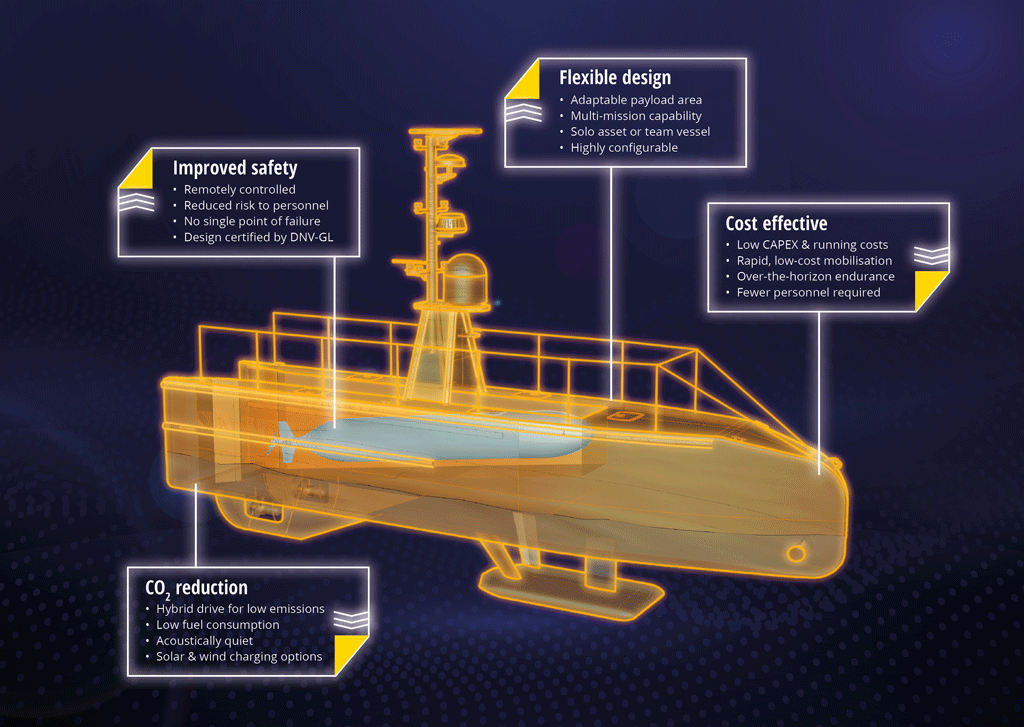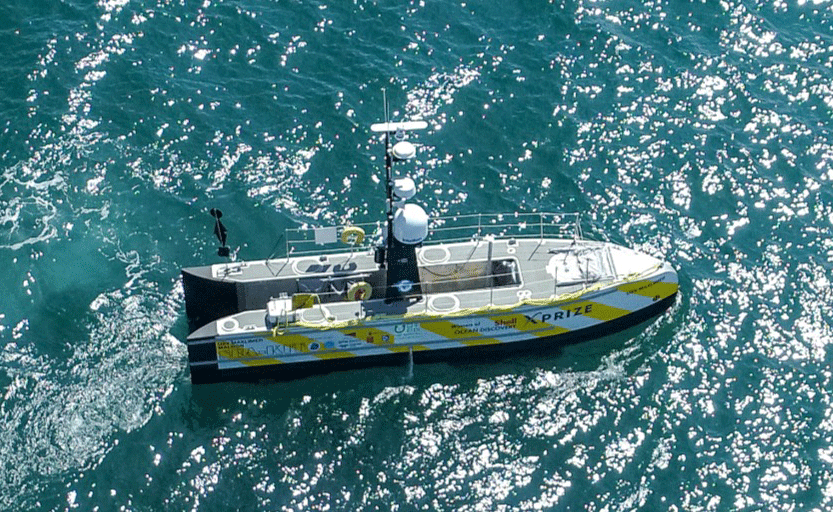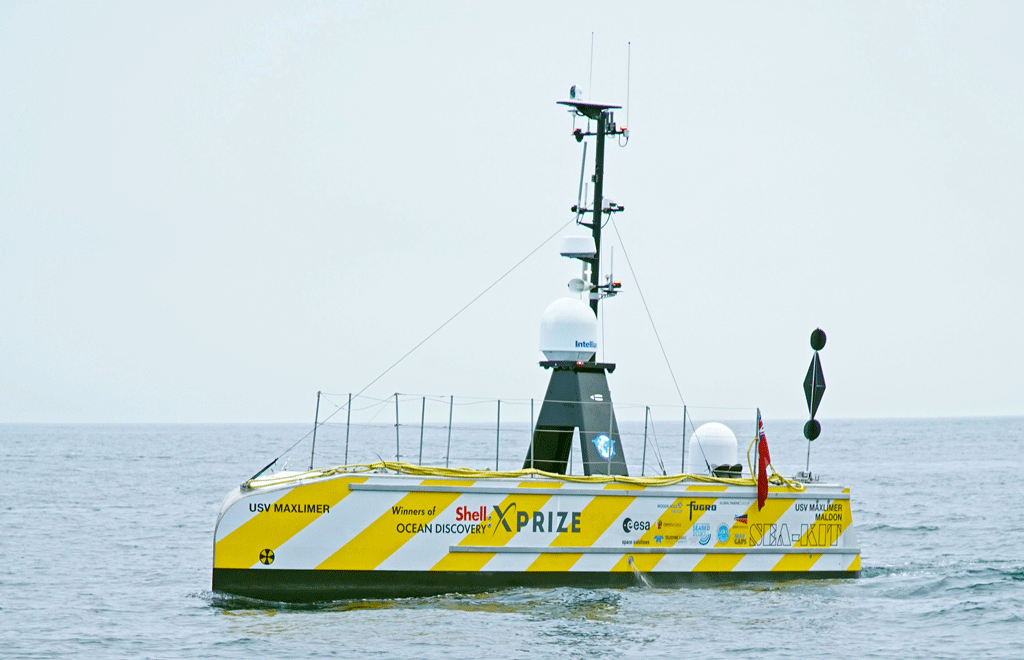?$article-big-img-desktop$&qlt=85,1&op_sharpen=1)
SEA-KIT 12m X-class USV, © Sonardyne International
Governments, scientific research institutes and industry are now taking the first steps towards developing a sustainable blue economy – that is, the use of ocean resources for economic growth while preserving the health of marine ecosystems. Among the challenges of doing so is the scope of survey work involved, which will be impossible to complete using traditional crewed vessels.
Not only are they expensive, fuel-hungry and difficult to mobilise, but they also have to be designed around the large number of crew needed to operate them, around 20–40 people working shifts over a 24-hour period. That crew also has to be mobilised and regularly rotated, with the multiple flights needed to get them to and from boats only adding to an already heavy operational carbon footprint.
From a health and safety perspective, working on a ship is more dangerous than similar jobs on land. In the UK the fatality rate at sea is about 12 times higher than in the general population. As a result, despite the rapid growth of offshore industries such as wind power, there is a growing shortage of seafarers globally as people opt for more settled lifestyles and jobs onshore.
But there is now a viable alternative. Uncrewed surface vessels (USVs) can spend long periods at sea, have a small carbon footprint, and are designed only to carry the payload and sensors needed to do the job, making them cheaper and faster to mobilise.

Doing more with less
With recent advances and innovation in sensors and imaging, satellite technologies, big data analytics and uncrewed and autonomous systems, we are now able to collect unprecedented amounts of information about the ocean.
As there is no need to accommodate crew, vessels can be built around payload and sensor requirements alone, making them smaller and more efficient in terms of power and hydrodynamics. The result is craft that can cost as little as 5–10% of a traditional vessel build and generate only 1–5% of the carbon emissions of a crewed ship.
For projects such as The Nippon Foundation GEBCO Seabed 2030 Project, this can have a huge impact on feasibility. This collaboration between The Nippon Foundation of Japan and the General Bathymetric Chart of the Oceans aims to bring together all available bathymetric data to produce the definitive map of the world ocean floor by the end of the decade and make it available to all.
It is estimated that it would take between 70,000 and 127,000 crewed vessel-years to map ocean floor greater than 200m deep – which represents some 94% of the seabed – and cost $3–5bn, not to mention generating more than 6m tonnes of carbon. In contrast, a fleet of USVs could complete the same task for less than $1bn and generate less than 50,000 tonnes of carbon. Transitioning from traditional crewed to uncrewed vessels would therefore eliminate the equivalent annual carbon footprint of more than 500,000 people in developed nations.
"Transitioning from traditional crewed to uncrewed vessels would therefore eliminate the equivalent annual carbon footprint of more than 500,000 people in developed nations"

Innovation and COVID-19
The need for uncrewed and autonomous offshore vessels has received renewed attention during the COVID-19 pandemic. While most sectors of the global economy have been badly affected and many field research activities put on hold, the USV sector has seen a rapid growth as vessel operators and research institutes look for innovative ways to maintain business continuity.
With many countries on lockdown, it has become a logistical nightmare to get crew to and from vessels. In August, the International Transport Workers’ Federation, a seafarers’ union, estimated that 300,000 of the 1.2m crew members at sea were essentially stranded on their ships, leading to fatigue, stress and mental health issues.
Conversely, companies operating uncrewed vessels have continued with minimal disruption, as operators control the vessels from the safety of remote control centres (RCCs) onshore. Since the pandemic took hold, for instance, SEA-KIT International has completed 2 large-scale demonstrations: the first showcasing Sonardyne’s Doppler velocity log, for environments where use of GPS is impossible; and the second a 22-day, 1,000km2 offshore survey of previously unmapped UK continental shelf.

Increased investment and development of a variety of internet-connected sensor technologies have accelerated the capabilities of these vessels. Providing remote operators with the necessary information to make decisions in real time enables USVs to be controlled safely and interact with other vessels offshore.
Data management
With increased uptake of these sensors across a number of industries, the technology has become relatively mature, resulting in more robust and accurate devices that are continuously decreasing in price. As these comprise a significant portion of a USV’s build cost, manufacturers can now cost-effectively innovate in response to the distinctive requirements for operating in maritime environments.
Because of the high volumes of data and data speeds required, USVs typically use expensive band frequencies. However, prices are decreasing with advances in satellite manufacturing and new launching services, and are set to decrease even further with the increase in low-Earth-orbit satellite systems such as Starlink. As well as offering increased bandwidth, these should bring the cost of the high-speed data services that cover our oceans in line with terrestrial connections.
Regulations often struggle to keep pace with innovative technologies, and legislation for the use of USVs is still in its early stages. However, regulatory bodies see the future value of uncrewed vessels and are increasingly supporting companies by providing a flexible framework for safely testing and demonstrating their capabilities. For example, for SEA-KIT’s 2019 North Sea crossing and more recent 22-day Atlantic survey, the UK Maritime and Coastguard Agency provided appropriate regulatory waivers.
Future of USV technology
In the maritime sector as a whole, the move towards zero-carbon fuels is gathering pace. The International Marine Organization has set the goal of reducing greenhouse gas emissions by at least 50% by 2050, which is encouraging increased research into alternative fuels, with a particular focus on methanol, biofuels and hydrogen fuel cells.
Because USVs are smaller in size, we expect to see increased use of 3D printing in the manufacture of vessels, allowing design to avoid the constraints imposed by existing materials. This will allow builders to prototype design that would traditionally have been too complicated and costly to develop.
To accommodate the ever-increasing volume of data being collected – monitoring phenomena such as climate change, ocean health, currents, tides, and the air–water interface – there will be a shift towards edge computing and AI to process it in real time. This is already becoming a reality with the development of systems such as Teledyne’s Mira AI, which is able to reduce the processing time for multi-beam echo sounder data significantly.
For example, it would take humans 250 hours to process the 400GB of data gathered on SEA-KIT’s recent 22-day Atlantic mission, whereas AI would take 3 hours, and a combination of AI and manual processing 61 hours. AI also enables onboard processing, which is particularly important during uncrewed missions as data can’t easily be transmitted to the RCC owing to bandwidth limits.
"It would take humans 250 hours to process the 400GB of data gathered on SEA-KIT’s recent 22-day Atlantic mission, whereas AI would take 3 hours, and a combination of AI and manual processing 61 hours"
With the falling cost of sensors and their increasing reliability and accuracy, we are also likely to see vessels themselves become more autonomous. Numerous USVs are already using AI for collision avoidance, with many operators stating that they are able to comply with the International Regulations for Preventing Collisions at Sea.
One key question that remains, however, is whether the sector will still need to employ people in the future. At SEA-KIT we firmly believe that, to maximise the benefits of autonomous technology for a sustainable blue economy, people will always need to be in the loop for functions such as quality control and assurance. RICS members, including hydrographic surveyors, who would like to be involved should continue to keep up with digital training requirements and get involved in projects as quality assurance roles represent a good fit for their data management and problem-solving skills and experience.
USVs are set to play a prominent role in the future of marine survey and inspection and we are starting to see wider adoption. SEA-KIT has already received 2 orders from Fugro for its first commercial vessels. Remote technologies are set to benefit everyone in the maritime sector significantly, enabling faster, more efficient and safer marine operations on a more sustainable scale.
Related competencies include: Big data, Environmental management, Hydrographic surveying
